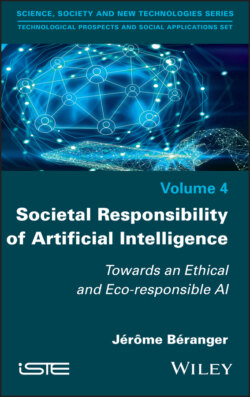Societal Responsibility of Artificial Intelligence

Реклама. ООО «ЛитРес», ИНН: 7719571260.
Оглавление
Группа авторов. Societal Responsibility of Artificial Intelligence
Table of Contents
List of Illustrations
List of Tables
Guide
Pages
Societal Responsibility of Artificial Intelligence. Towards an Ethical and Eco-responsible AI
Acknowledgments
Introduction
ALGORITHMIC PROCESSING.–
BIG DATA.–
BLOCKCHAIN.–
CROWDSOURCING.–
DEEP LEARNING.–
WEAK AI.–
STRONG AI.–
MACHINE LEARNING.–
ETHICS BY DESIGN.–
ETHICS BY EVOLUTION.–
1. Societal and Moral Questioning Around AI and Its Ecosystem
1.1. Use cases of AI
CHATBOTS.–
1.2. Digital environment
DATA DRIVEN.–
API.–
CLOUD COMPUTING.–
1.3. What is the place for human beings in this digital society?
BUSINESS INTELLIGENCE.-
1.4. Technological and societal issues
ADMINISTERED DATABASE.–
BIG TECH.–
FREE AND INFORMED CONSENT.–
CYBERSECURITY.–
1.5. Ethical and moral issues
OPEN SOURCE.–
ANONYMIZATION.–
2. The Ethical Approach to AI
2.1. Definition of ethics
2.2. General ethical principles
2.3. Problems and ethical issues specific to the digital environment
OPT-OUT.–
Box 2.1.Biases in numerical data
Box 2.2.Effects of algorithms on individuals
DYNAMIC PRICING.–
FAKE NEWS.–
Box 2.3.Learning algorithms and transparency
COMMUNITY MANAGER.–
ACCOUNTABILITY.–
2.4. Ethical criteria and better risk assessment of AI-related digital projects
TURING.–
MERISE METHOD.–
SOURCE CODE.–
2.4.1. Data ethics
2.4.2. Ethics of algorithms
2.4.3. Ethics of systems
2.4.4. Ethics of practices
2.4.5. Ethics of decisions
2.5. Analysis of AI-related knowledge
CYBERNETICS.–
COMPUTOSPHERE.–
INFOSPHERE.–
3. Ethical Framework Associated with AI
INDUSTRY 4.0.–
LIVING LABS.–
3.1. Ethical charter around AI
3.1.1. Data ethics
3.1.2. Ethics of systems
3.1.3. Ethics of algorithms
3.1.4. Ethics of practices
3.1.5. Ethics of decisions
PRIVACY BY DESIGN.–
3.2. Recommendations for AI
3.2.1. Data ethics
3.2.2. Ethics of systems
3.2.3. Ethics of algorithms
3.2.4. Ethics of practices
3.2.5. Ethics of decisions
OPEN DATA.–
SANDBOX.–
NOSQL.–
HADOOP.–
Box 3.1.Ten key points of ethical data
GDPR.–
DATA SCIENTIST.–
DATA ENGINEER.–
DATA STEWARD.–
DATA ANALYST (BUSINESS ANALYST).–
DATA OWNER.–
3.3. Temporality relative to the human guarantee in digital technology
HUMAN GUARANTEE OF AI.–
3.4. For the health user and for health user representation
EMPOWERMENT.–
3.5. For health personnel and for the representation of health personnel
TEST AND LEARN.–
ROI.–
3.6. Environmental parameters of digital technology
DEEP NEURAL NETWORKS.–
Box 3.2.Environmental parameters of NICTs within a company
3.7. Regulation associated with AI
3.7.1. Structural parameter
3.7.2. Technological parameter
3.7.3. Strategic parameter
3.7.4. Methodological parameter
3.7.5. Organizational parameter
3.7.6. Regulatory parameter
3.7.7. Relational parameter
3.7.8. Cultural parameter
DATA VISUALIZATION.–
3.8. Algorithmic systems and digital data governance
DATA MINING.–
PUSH.–
COOKIES.–
LOG.–
3.9. Four key steps for an AI project. 3.9.1. Step 1: determine the project objective
3.9.2. Step 2: collect and prepare relevant data
KNOWLEDGE GRAPH.–
3.9.3. Step 3: classify data and choose tools
3.9.4. Step 4: produce the model
3.10. Algorithmic responsibility
4. Anticipation Around Artificial Consciousness
4.1. Protean aspects of consciousness associated with intelligence
Box 4.1.Different forms of intelligence
4.2. Structuring of consciousness
Box 4.2.Structuring consciousness
4.3. Neoplatonic systemic ethical modeling (Ψ, G, Φ) of an artificial consciousness
Box 4.3.Knowledge communication processes
4.4. Process of creating practical wisdom from artificial consciousness
4.5. Morality of a “strong” AI
Box 4.4.Pitfalls to avoid for “strong” AI
Conclusion
Appendix 1. Ethical Charter of Using AI in Judicial Systems and Their Environment
Appendix 2. Practical Recommendations of the CNIL Regarding the Ethics of Algorithms
Appendix 3. OECD Recommendation on AI
Appendix 4. Questions Concerning the Application of Ethical Standards. A4.1. Question 1: universality of standards
A4.2. Question 2: moral saturation
A4.3. Question 3: bias
A4.4. Question 4: integration and compatibility of standards
A4.5. Question 5: trust
A4.6. Question 6: environment
Appendix 5. CERNA Recommendations on Machine Learning
Appendix 6. Reasons for a “Digital Divide”
Appendix 7. Holberton–Turing Oath
A7.1. Holberton–Turing oath
A7.1.1. Humanity and ethics
A7.1.2. Data science, the art of artificial intelligence, privacy and personal data
A7.1.3. Daily work and etiquette
Appendix 8. Report Proposals: “For a Controlled, Useful and Demystified Artificial Intelligence” A8.1. For a controlled artificial intelligence
A8.2. For useful AI, in the service of humans and humanistic values
A8.3. For a demystified AI
List of Abbreviations
References
Index. A, B
C
D, E
F, H, I, J
M, N
P
Q, R
S
T, U
WILEY END USER LICENSE AGREEMENT
Отрывок из книги
Technological Prospects and Social Applications Set
.....
Weak AI or narrow AI simulates specific cognitive abilities such as natural language comprehension, speech recognition or driving. It only performs tasks for which it is programmed. It is therefore highly specialized. It is a machine for which the physical world is somewhat enigmatic, even ghostly, if it perceives it at all. It does not even have any awareness of time. This AI is unintelligent and works only on the basis of scenarios pre-established by designers and developers.
Artificial general intelligence (AGI) or strong AI has similar – and even superior – reasoning abilities to those of human beings. It is endowed with capabilities not limited to certain areas or tasks. It reproduces or aims to reproduce a mind, or even a consciousness, on a machine. That is to say, an evolutionary machine with its own reasoning and consciousness, capable in particular of independently elaborating strategies and/or decisions that go beyond human beings in order to understand them so as to help them (in the best of cases) or to deceive or even destroy them (in the worst of cases).
.....